THE TECHNICAL SIDE: GILDING TECHNIQUES IN ILLUMINATED MANUSCRIPTS & HERALDRY*
 Anthony Wood, FSHA
Anthony Wood, FSHA
Newsletter No. 9, Summer 1992
Gold used in gilding comes in two forms, leaf and powder. Both are almost pure and not usually less than 23 carat. The leaf is supplied in books of 25 leaves, each 34” sq. and sandwiched between thin sheets of tissue paper. If the paper is pink, as supplied by some manufacturers, it is because gilder’s rouge has been scattered between the leaves. This is to be avoided because it gets on to the working surface and gives a pink tinge to the work, which is difficult to remove.
It is supplied in what is called by the trade Transfer Gold. This is simply leaves of slightly less pure gold squeezed on to a tissue paper backing and held there purely by pressure. The advantage of using it is that only that gold which comes into contact with whatever adhesive is used, comes off the backing and the remainder can be re-used until there is none left, which makes it more economical. The disadvantage, at least with English transfer leaf, is that it will not burnish well, if at all.
Gold leaf is otherwise sold with various descriptions such as Illuminating gold which is usually 234 carat or as Fine gold, which is 24 carat, depending on the manufacturer. A less pure leaf is said for use for gilding outside by decorators and letter cutters and for bookbinders. The price of a book of leaf varies depending to some extent on the current price of gold on the world market, but it is usually around £16 per book.
Silver leaf can be bought, which looks every bit as sharp and beautiful as gold, but it will begin to tarnish badly after only a few months. An adequate substitute is aluminium leaf, which although it has none of the brilliance of gold, will last, and is used in the same way. A very much more expensive alternative is platinum leaf. This is much more expensive than gold, and even when burnished to its fullest extent looks so like aluminium that it is not worth its considerable cost.
Gold powder is made from leaf by grinding it in a mixture of salt and honey% These are washed out in due course, leaving a fine gold powder. This is mixed with gum Arabic or a similar adhesive, and either written from a pen or applied with a brush like any other pigment. It is still sold commercially to the unwary as Shell Gold. Until quite recently, it was supplied by artists’ colourmen in mussel shells acting as palettes, hence its name, but this is a very expensive way of buying it and works out at several times the cost of powder bought unprepared. Shell Silver and aluminium are also obtainable but with the same proviso.
The receptacle in which it is kept, the water pot used to wash out brushes and the brushes themselves should all be kept exclusively for gold powder. Much of it is transferred to the water pot during the course of work and if this is swilled down the sink nearly half the powder will be lost. At around £38 a gram, this is not recommended.
The advantage of using powder gold is that it is much more flexible in use than leaf and can be modelled up with colour and patterns and highlights burnished into it Its disadvantage is that it does not appear raised and will not burnish anything like as brightly as leaf. In heraldry it is essential for the best work.
Leaf can be applied basically in two ways, either directly to the working surface, just by using a water gold size, which is essentially a water based varnish, or over gesso sot lie (Italian for fine plaster). Water gold sizes can be bought commercially and are quite effective for large undetailed work, being the cheapest way of gilding a given area. The disadvantage of using them is that the leaf can neither be burnished well nor have fine detail painted onto it. There are other substitutes such as gum ammoniac and cryla gloss which are easy to use and give a slight raising to the leaf, but they do not burnish well and are poor substitutes for the traditional way using gesso.
Gesso is made to a tried and tested formula as follows: 8 parts (by volume) of slaked fine dental plaster, 3 parts lead carbonate (which must be treated with care because it is poisonous), 1 part of animal glue (sold under the trade name of SEMMENE, and now only obtainable from very few stockists), and 1 part preserving sugar. The ingredients are ground up together with rain or distilled water in a mortar and a small amount of an inert brick red powder called Armenian bold added so that the resultant mixture can clearly be seen in use. It is then decanted into a shallow tray made from transparent plastic sheet common in packaging and left to dry out.
When almost dry it can be sliced into conveniently sized bricks and left for use later. It must be allowed to dry out thoroughly before any attempt is made to use it. When required, a brick is placed in a small pot with a screw top in which makeup is often sold, and several drops of rainwater added from a pipette. This should be just enough to allow the brick to melt, but not sufficient to make it runny. The next day it is carefully stirred with a bone folder or its equivalent and more water added until it has the consistency of gouache colour ready to use. It should be JUST runny enough to run well out of a pen. If applied with a brush it can be used a little thicker but still wet enough to spread easily and lie flat.
The principal aim in laying gesso is to get it all down on a given form before any part of it dries out. Flooding it on well requires practice, and care must be taken to ensure that the thin parts of a form (such as a letter) are built up with extra gesso before it dries. With much practice, liberties can be taken with it which are not open to the novice. It often dries with a sunken ridge down the middle of the form. No one knows quite why this happens, but it can be cured quite easily by gentle scraping with a sharp craft knife, It is always prudent to lay a test piece at the same time.
The general principle of raised gilding is that when the gesso has dried, it can then be breathed on, to moisten the surface, the leaf applied and polished with either agate or hematite burnishers. The surplus gold is brushed away with a fan-shaped brush kept specifically for the purpose. Aluminium leaf can be applied in the same way, but on a gesso with slightly more glue and sugar in its composition. The essential difference between the two is that gold has the unique property of being able when moist, to stick to itself, so that several layers of leaf can be applied over each other. Aluminium does not and if the first layer of leaf is a failure, the gesso must be scraped off and the process repeated.
The art of raised gilding is the most difficult, but the results when it is done well are spectacular and most beautiful. When it goes well, it appears to be so easy and the results come rapidly without a struggle. When it does not, a great deal of time and material can be wasted. Much of the skill can only be acquired by constant practice and experience though there are several books (listed below) which give comprehensive instruction in the technique. However, personal tuition from an experienced gilder is the quickest and probably the cheapest way of obtaining good results.
Using raised and burnished gold successfully presents problems for the inexperienced. Its chief merit is that it will burnish to great brilliance and shine out on the work. This has its own drawback in that when viewed from some angles it appears almost black. In heraldry, unless used on either the pages of a book or on a skin which is not stretched and therefore has to some degree an undulating surface, it will appear to blend into invisibility with the surrounding colour unless seen from the best angle. This means that it must be out strongly by one means or another for the form to be clearly defined.
The other disadvantage of using it is that because the surface is both smooth and polished, little if any detail can be included within the gilded form. It can with difficulty be painted on, but there is always the real likelihood that, in due course, the paint will either flake or be rubbed off as though it had been painted on glass. Large areas of raised burnished gold are the most difficult to accomplish technically and present this problem at its most acute. Thus, it is more effective to use on small scale objects or Ordinaries, where a simple strong outline is all that is required rather than large charges needing detailed painting.
* Readers should note that any product names/brands, pricing, and addresses shown were contemporary of the date of the article and may no longer be valid. They are included here for reference only.
